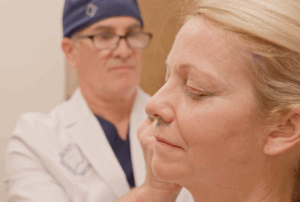FAQs
Welcome to our FAQ area, where you will find answers to commonly asked questions about aesthetic surgery. Strong patient education is essential to maximizing satisfaction after aesthetic surgery and by clearly explaining what to expect before, during, and after your surgical procedure, our team can help you set realistic goals, reduce your anxiety around the process, and feel more confident in your care.
While this section is not to be referenced in place of a consultation, San Diego plastic surgeon Scott Miller, MD, FACS is passionate about keeping patients well-informed and provides invaluable information about surgery below. We invite you to read through these frequently asked questions and contact our team to schedule your consultation.
Explore Topics On This Page
Commonly Asked Questions About Plastic Surgery
Will aesthetic surgery hurt?
During the procedure, you’re comfortable and will feel no pain. After surgery, pain and discomfort can usually be controlled with medication and reactions subside in a matter of days.
How soon after a cosmetic procedure can I get back to work?
It depends on the procedure and the nature of your job. Most plastic surgery patients are back to work within 7 to 10 days. More physically demanding work may require longer downtime before returning back to one’s normal routine. Rest assured that Dr. Miller and his team will monitor your recovery process after your procedure and advise you accordingly.
Will people be able to tell I’ve had plastic surgery?
Usually not. Good plastic surgery doesn’t leave you looking plastic. It enhances your looks naturally, and the improvement is often attributed to a vacation, a new diet, or an effective exercise regime.
How long will plastic surgery results last?
Rejuvenation procedures can’t stop the clock, but they can resist it. The benefits from a facelift, eyelid surgery, brow lift, and facial peels can last 5 to 15 years. Alteration procedures that reshape or correct an imbalance, such as surgery of the nose (rhinoplasty), chin augmentation, breast augmentation, and breast reduction, offer permanent benefits that last a lifetime.
Will there be scars after my surgical procedure?
Yes. Will they be noticeable? Probably not. Plastic surgeons make every effort to minimize scars and hide them in natural lines and creases. For the majority of procedures, scars fade over time, becoming barely noticeable.
How long does plastic surgery take to perform?
Not as long as you would think. Most procedures are performed as an outpatient, require no overnight stay, and take only a few hours.
Will insurance cover my procedure?
Usually not. But there are occasionally exceptions when a procedure is medically necessary. Often, this involves coverage for a portion of the expenses.
Can I finance plastic surgery?
In most cases, yes. Plastic surgery financing is now a readily available, accepted form of payment. Low monthly payments make virtually every procedure instantly affordable.
Is plastic surgery for men more popular now?
Yes, many men are staying fit, and it is not a sin to want to look your best. For these patients, Dr. Miller developed the SMART LIFT (simplified muscle access, release, and temporal lift). This approach allows him to naturally rejuvenate the eyes, brow, and forehead through a discreet upper eyelid incision.
What should I do next?
A consultation with a qualified surgeon is a quick, easy, and no-obligation way to find out what plastic surgery can do for you.
What Should I Look for in a San Diego Plastic Surgeon?
There are four critical factors to achieving extraordinary results. Dr. Miller directly explores these tenets in the excerpt below:
- Training: Board certification by the American Board of Plastic Surgery (ABPS) denotes the educational background, experience, and commitment to top-notch results you want in your plastic surgeon.
- Technique: You want a surgeon who has a focus to their practice. Additional training beyond the “bare minimum” reflects commitment, experience, and expertise in your area of concern. I attained advanced training with one of the masters in Cosmetic Plastic Surgery because I love helping people look their best. I have a focus and dedication to Facial Rejuvenation and Cosmetic Plastic Surgery of the breasts and body. From cleft lip patients on medical missions to my aesthetic/cosmetic surgery patients, this is my focus and my goal.
- Artistry: As Michaelangelo said, “Details are no Trifle.” Many surgeons are technically adept, but artistically lacking. Their patients heal, but do not look their best. Other surgeons have an “eye” for aesthetics, balance, and beauty. The patient and surgeon must agree on what looks good! If they do not agree, they are headed in different directions and the chances of mutual satisfaction is slim.
- Compassion: Francis Peabody, a physician and philosopher, said, “The secret to care of the patient is caring for the patient.” In order to achieve excellence, we have to care enough to do our very best.



